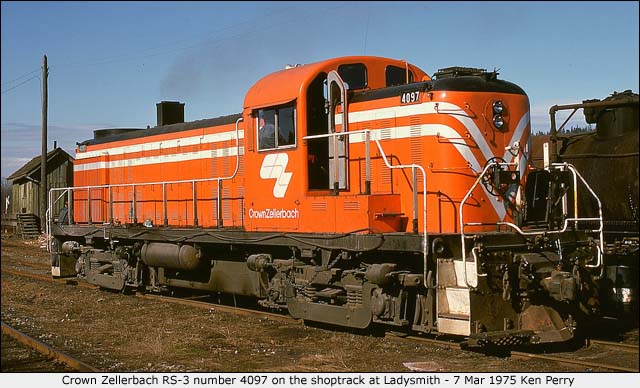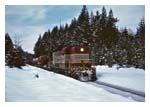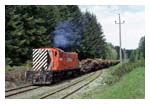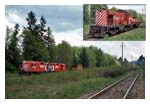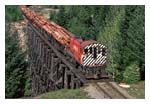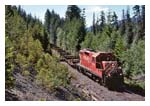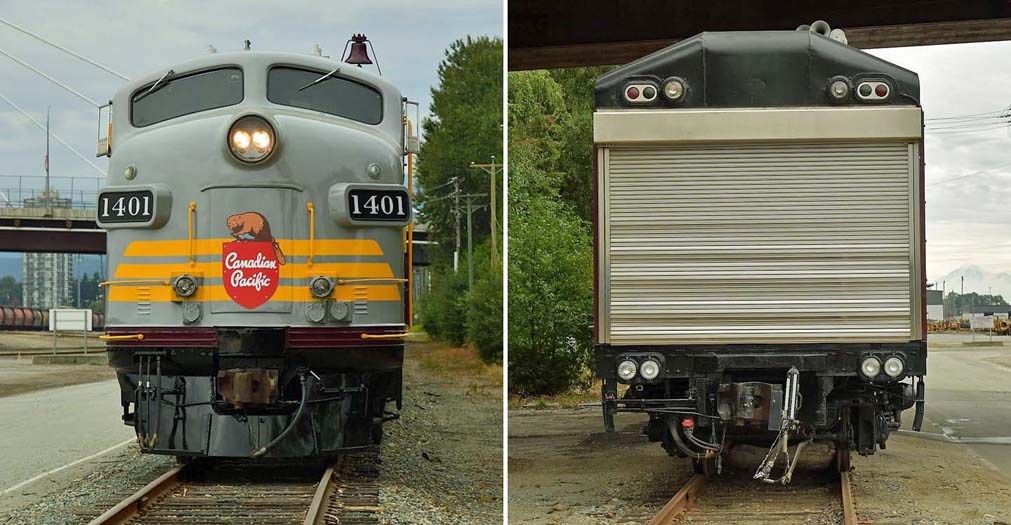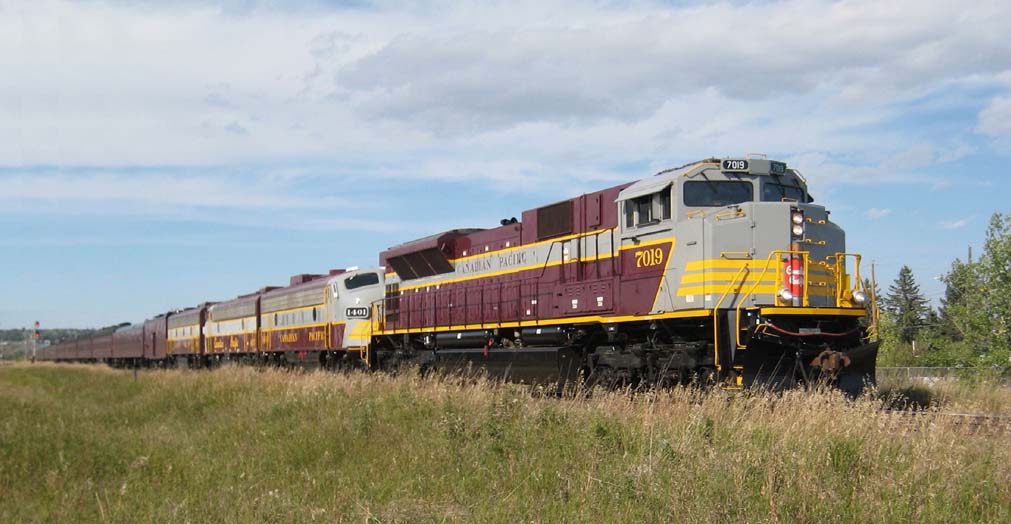 | Canadian Pacific Odds and Ends - Part 16 Articles |
| Black Box - Andy Cassidy Buck Crump's Love Affair With the CPR - Fred Bodsworth Crown Zellerbach Borrowed Locomotives - Ken Perry Mountain Lights - Multiple Authors More Toast - Andy Cassidy Royal Canadian Pacific - Andy Cassidy Tie Downs - Andy Cassidy Winterization Hatch - Andy Cassidy OKthePK's website "Last Call" page has appeared weekly over the past few years. Each week a different article told the story of various railway items of interest. While some of the articles were saved they are no longer available online. Many of those about the Canadian Pacific Railway have been compiled here on this page. There is insufficient room to display more than a few Last Call articles per page. As a result, "Canadian Pacific Odds and Ends - Part 16", continues this month with more possible parts to follow as time passes.  Black Box Andy Cassidy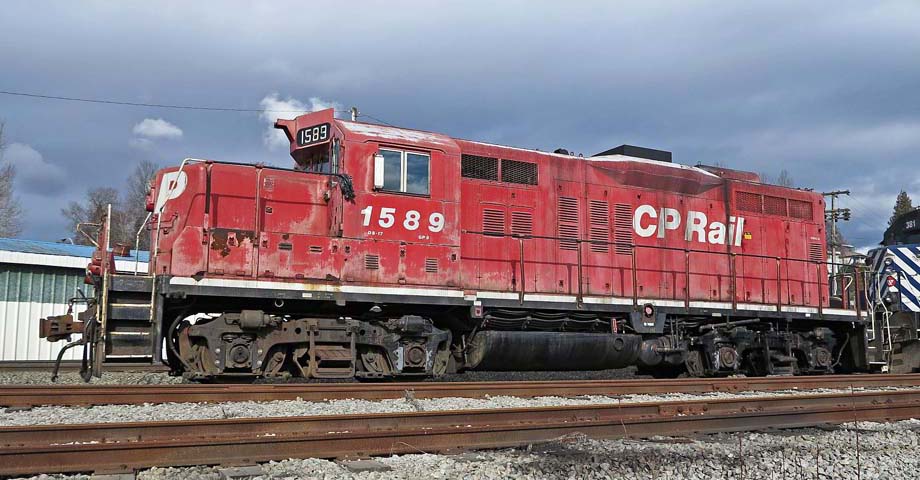 GMD built GP9u CP number 1589 in the dead line at Southern Railway of BC - 13 Feb 2014 Andy Cassidy. Of special interest to me was GMD built GP9u Canadian Pacific Railway number 1589. 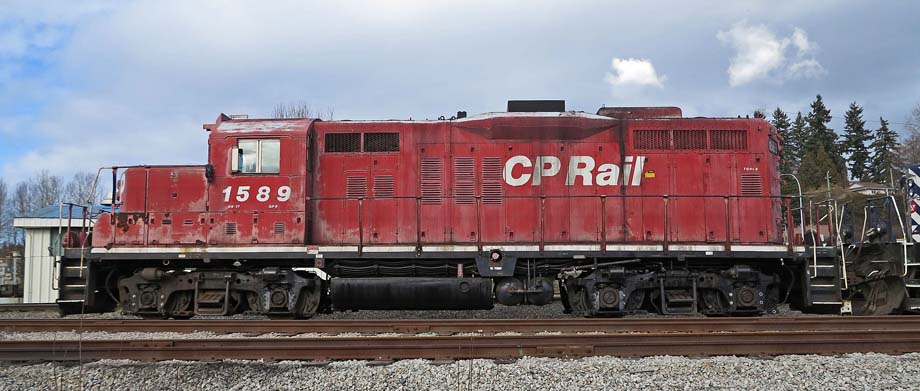 GMD built GP9u CP number 1589 in the dead line at Southern Railway of BC - 13 Feb 2014 Andy Cassidy. 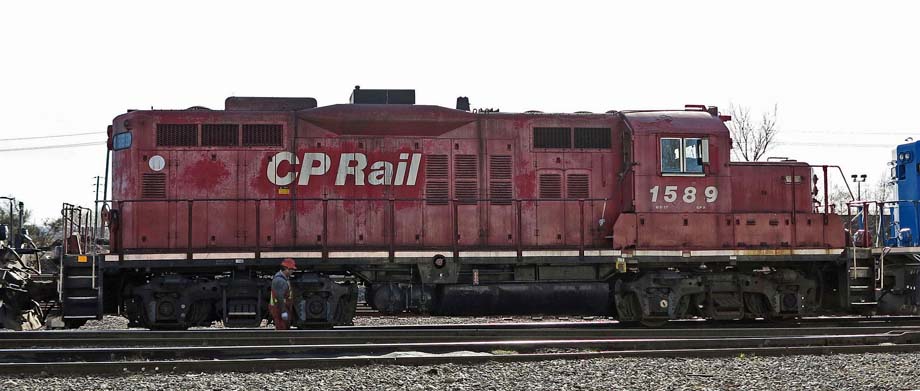 GMD built GP9u CP number 1589 in the dead line at Southern Railway of BC - 13 Feb 2014 Andy Cassidy.  Buck Crump's Love Affair With the CPR Fred Bodsworth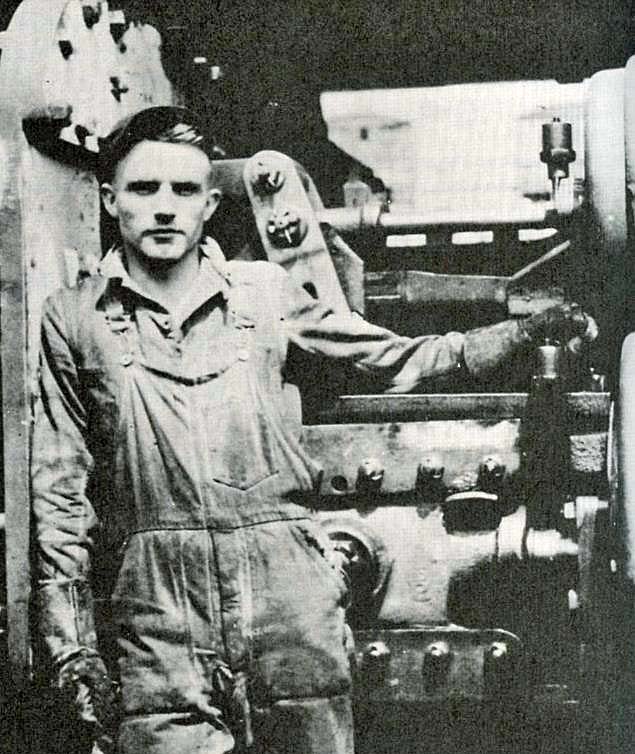  12 Nov 1955 At twenty-three Buck Crump, the machinist's apprentice, worked in CPR's Weston Shops at Winnipeg to pay for a course at university. He still hates to see a dirty locomotive. It began when he was a starry-eyed fifteen. He lived in a CPR house, grew up beside the tracks, quit school to work for the railroad and went back to learn what makes it run. He saw every mile of track and met most of the 87,000 employees. Then for ten years he was groomed to be president. At fifty-one Buck Crump, the president, spends half a billion dollars a year for CPR. But he can't resist signals and schedules and always keeps his eye peeled for hotboxes. Early last May directors of the Canadian Pacific Railway sat around the big oval table in their ornate, walnut-trimmed board room above Montreal's Windsor Station and unanimously elected Norris Roy Crump, a former forty-cents-anhour track laborer, as CPR president. It was the climax of a thirty-five-year love affair for the short, dapper, railroader who rose from a "rip track" gang to the presidency. At fifteen Crump was lured from school in Revelstoke, B.C., by the glamour of railroading. He fell in love with the CPR, and the love knot held. It's true that the object of his affections tossed him aside during the depression layoffs in 1929, and put him out to tramp the streets of Winnipeg looking for another job. But they made up, and perhaps it can be said that the CPR next fell in love with Crump, because after a rapid rise he has become, at fifty-one, the youngest president elected since 1918. In Vancouver his father, Thomas H. Crump, eighty-four and a CPR man too, heard the news and told reporters, "There's one thing you can be sure about a Crump. We all started out by learning how to use a No. 2 shovel." No man has come to the CPR presidency better groomed for the job. Buck Crump (he has forgotten where the nickname originated) learned the railroading business with prodigious thoroughness. He was born in a CPR-owned home and grew up beside the CPR tracks. He started at the bottom and worked his way up through the great labyrinthine CPR empire, picking up a couple of university degrees in mechanical engineering along the way. He has had CPR experience in all its Canadian regions, he has traveled back and forth many times over every mile of its 21,000 mile track system, and he has met personally a large percentage of its 87,000 employees. And the man now responsible for spending four hundred million dollars a year knows what it's like to be broke, for Buck Crump remembers vividly the grim jobless days of 1929. Today, as president, Crump has a finger on the whole vast operation and can discuss with equal familiarity the interest rate of CPR's latest collateral trust bonds, the gear ratio of its newest locomotives, or the number of ties it takes to lay a mile of track. Though fully occupied now with the problems of top-level administration, he is still a practical down-to-earth railroader who cannot ride on a train without unconsciously checking its speed and schedule. His personal office car, the Laurentian, has been fitted with a speedometer and a panel of instruments to keep him informed of the locomotive's mechanical operation up front. On the rear corner of his private car is a mirror giving him a view of the track signals ahead which, from long habit, he cannot keep himself from watching. When a freight rumbles by, Crump usually drops his desk work, and like all trainmen, peers out the curtained windows of his car to watch for hotboxes on the passing train. The job itself has a glamorous history. At one time it would automatically have assured Crump fame and a prominent place in Canada's history. But if the record of recent presidents is repeated, the job today assures Crump only hard work, tremendous responsibility, and then at the end of his term, an abrupt fade-out into the limbo of anonymity from which he came. For the CPR presidency, once the most glamorous and illustrious job in Canada, has lost most of its lustre. A question now being widely asked is, will Crump put some of that old-time lustre back? Modest, publicity-shunning Crump, who insists on friends still calling him by his boyhood nickname, "Buck," is a striking contrast to the flamboyant, aristocratic, and titled gentlemen who once lent color and pomp to CPR's top job. For the first fifty years of its seventy-five-year history, CPR's presidents were personifications of their times. With top hat and cane they traveled throughout Canada in their private railway cars with all the pomp and fanfare of Hindu rajahs on a Ganges pilgrimage. High school boys thirty years ago who couldn't remember the names of half of Canada's prime ministers had no difficulty rattling off the names of Lord Mount Stephen, Sir William Van Horne, Lord Shaughnessy, and Sir Edward Beatty, CPR's "big four" who controlled the company for its first sixty years. The odds were, if a high school boy of that era dreamed of attaining greatness, he dreamed of becoming CPR president and not prime minister. But something happened to the CPR presidency after Beatty retired in 1942. The colorful era of railroad pioneering and expansion was past. The war was producing a new crop of public heroes. And the three hustling and capable presidents who followed Beatty were all older men, forced by age and health to retire before they had become public personalities. Whether or not Crump wins a place in history beside CPR's other presidential giants, he is already, as CPR chief, one of the biggest and most influential men on the Canadian industrial and business scene. The government owned Canadian National is bigger than the Canadian Pacific, but since the CNR is not a true free enterprise example the government looks to the privately operated CPR as the "yardstick" against which the nation's freight rates and railway regulations are gauged. Thus Crump's decisions for CPR can have indirect effects far beyond the railway network he himself controls. And that isn't all, for Canadian Pacific is far more than a railroad. The railway that Crump manages is actually only the core of a tangled skein of corporations representing a score or more of different businesses. CPR also owns some fifty ocean, coastal, and inland steamships. Its Canadian Pacific Airlines operate schedules throughout the Canadian north as well as to the Orient, South America, Mexico, Australia, and across the Arctic to Europe. It owns Canada's largest hotel chain and a 200,000 mile telegraph network. With a million acres of real estate (almost the area of Prince Edward Island) CPR is Canada's largest landowner and biggest taxpayer. It controls Consolidated Mining and Smelting of Trail, B.C., the world's largest lead and zinc mine. It is in the meat-packing business with a couple of stockyards and abattoirs. It has coal mines in the Rockies, oil wells in Alberta, grain elevators, bus and truck lines, and a macaroni factory. It operates Turkish baths, dance halls and the western hemisphere's largest glass-covered saltwater swimming pool. Among its diversified revenues are the good luck pennies that tourists toss into Nova Scotia's Evangeline's Wishing Well, because Canadian Pacific owns that too (but the pennies go to charity). This is Crump's vast and multifarious empire. In one way or another it reaches daily into the lives of every Canadian. Too Busy to be an Athlete When you see him seated behind his desk in the big Windsor Station office that has been used by all Canadian Pacific presidents since Lord Shaughnessy, Crump looks like a big man. His shoulders are thick and broad, and his face is round and full. But when he stands up his resemblance to a football lineman suddenly disappears, for he is surprisingly short, about five foot six. He is stout and chunky with little fat, weighs 165 to 170 pounds, and never has to worry about weight. He says he was never an athlete "because I was always too busy working on the railroad." His hair is slick and straight, now largely grey. He dresses plainly, usually in grey suits and striped shirts, in fact no differently than the clerks selling tickets in the big waiting room directly below his office. Sometimes when he smiles, tiny crow's-feet shoot out from the corners of his blue eyes, but these fleeting, skin-deep wrinkles are all he has, and if anything, he looks a little younger than his fifty-one years. He smokes cigars constantly. When he became CPR president last spring a Montreal reporter asked him if he had any specific aims for himself or CPR. Crump replied, "I just want to be the best darned railwayman and the best family man I can." His record is a good one, on both these scores. He is married, and he and Mrs. Crump celebrated their twenty-fifth wedding anniversary last 23 Aug 1954. They have two daughters. Ann, twenty, is attending Queen's University, Kingston, Janice, thirteen, attends public school in Hampstead, the western Montreal suburb where the Crumps live. Crump believes strongly that his home is his private refuge and he is striving to keep his family out of the public eye. Unlike the salary of CNR's Donald Gordon, which is a matter of public record, Crump's salary is a private matter between him and his directors, and only he and the directors know what it is. It is almost certainly no less than Gordon's seventy-five thousand dollars a year, and has been reported without denial or confirmation to be a hundred thousand. But the Crumps are poor candidates for the ranks of the nouveaux riches, for they are still living a modest fifteen-thousand-a-year way of life. They live in a middle class forty thousand-or-so house and have no house staff except a cleaning woman who comes around twice a week and a gardener who visits them about once a week. Janice goes to the closest public school. And last summer, instead of basking at a swank vacation resort, Crump took his two daughters on the organized six-day "Trail Ride" in the Rockies (another CPR venture), riding in the saddle all day and sleeping on the ground on spruce-bough beds at night. Nor does Crump keep executive hours. His average working day as president is a little longer than it was thirty years ago when he was a machinist's apprentice wiping soot from locomotives. In their Hampstead home, the alarm goes off and Buck Crump rises at 07:30 to begin his working day. He rushes through the morning paper with breakfast, and leaves the house before 08:30. He drives his own five-year-old Buick to the office, usually alone, but sometimes dropping Janice at school on the way. The Buick he describes as "CPR-freight-car-red when it's washed." Normally it takes him thirty minutes to drive the four traffic-congested miles between Hampstead and Windsor Station. He parks in a small CPR-owned outdoor parking lot adjoining the station. The lot is reserved for railway brass and President Crump's car is often one of the oldest there. Mrs. Crump doesn't drive, hut the Crumps rate technically as a two-car family by virtue of a scratched and wrinkled military station wagon of wartime vintage which is kept for summer use at the Crump cottage near Parry Sound, Ontario. The station wagon is now painted a bright blue and is reverently known as "The Goose." As CPR president, however, Crump has the use of a third car, a glistening, half-block-long, company-owned, Cadillac, complete with full-time chauffeur. The chauffeur is described as the least busy employee on Canadian Pacific's 87,000 man payroll. Crump uses the president's car only on formal occasions and for occasional downtown business calls. At the end of the day he climbs back into his ageing Buick for his nightly wrestle with Montreal's traffic jam. So Crump seems to have no desire for the lavish way of life that was once the chief trademark of the job he holds. How did he get the job? His own explanation is, "You have to work like the devil, and then be around when the breaks happen." Most of the way, Crump climbed the CPR ladder with his own efforts alone, until he reached the point where his abilities came under the eyes of the top brass, then he was pushed. At least ten years ago Crump was earmarked as a future CPR president and was deliberately moved into jobs that would round out his experience. Some see in CPR's recent history a policy of appointing shortterm presidents "to keep the chair warm" until young Buck Crump was sufficiently groomed to take over. As usually happens with prominent men. the legends are already beginning to build up around Crump. One of the most persistent is that he was born in a freight-train caboose. He insists he wasn't. "I was born in the beautiful little town of Revelstoke, in the picturesque valley between the towering Selkirks and the Rockies," he says, reciting home-town chamber of commerce propaganda. Crump's father, Thomas H. Crump, had come from England to the Canadian west in 1890, decided farming wasn't for him, and gone to work on a CPR track gang. One day a few months later at Gleichen, Alberta, the boss discovered that Crump Sr. could read and write English, a rare ability in a section hand at that time, and that very day he was made a clerk. Crump Sr. wound up a divisional superintendent, now retired, he lives in the Hotel Vancouver. Buck Crump's mother went west from Dundas, Ontario, to Portage la Prairie in 1883. Buck, his two brothers and a sister all became Canadian Pacific employees. It was little wonder, for all were born in (CPR-owned homes, their playmates were from CPR families and they lived and played beside CPR tracks. Buck's only sister, now Mrs. W. McGinnis of Seattle, was a CPR stenographer for several years. His elder brother Edward is now CPR agent at Sicamous, B.C., and younger brother Jack is a public relations officer for CP Airlines at Vancouver. Like most railroading families, the Crumps moved frequently. "We jumped all over the place," Crump says, "just as my own daughters had to do years later." Before he was eleven, he had lived in Revelstoke, Field, Grand Forks, Vancouver and back in Revelstoke again. By then railroading was in his blood. If No. 18 failed to go through on time, rattling the windows and dishes in the Crump's track-side home, young Buck would awaken and wonder why, but if it thundered through on schedule he slept on. Before rising he would lie in his bed and listen to the rumbling echo of the morning passenger coasting down Eagle Pass, or a freight bucking its way up the Illecillewaet valley. In June 1920, he was fifteen, old enough to start work, he thought. He got a job on the Revelstoke repair track, the "rip track" to railroaders. It was the siding on which damaged cars were repaired, their wheels and drawbars changed. "I wasn't allowed to touch a wrench," he says, "1 was there just to do the heavy work, to lug the drawbars around, and clean up the track afterward. September came, dad wanted me to get back to school, I wanted to stay on the railroad. He put up a big kick, but finally he said, Okay, if you want to be a railroader, be something worth while, and don't spend your life lugging drawbars around a rip track." Crump Sr. arranged for Buck to go to Field to begin the five years of apprenticeship that would qualify him as a machinist. "When I left Revelstoke," he says, "the prospect of becoming a machinist looked like big stuff, the top of the ladder." But two years later, still a machinist apprentice, he was moved to the big CPR Weston Shops in Winnipeg, and there began to see that there were bigger, more interesting, and more challenging jobs than being a machinist. He decided to go to university and become a mechanical engineer. For two winters he attended night classes at Winnipeg's Victoria-Albert School to round out his entrance requirements. All day he would work in the shops, continuing his apprenticeship. It was heavier work than now, because today's railway shops are extensively mechanized. At five o'clock every afternoon he would hurry to his room at Winnipeg's "Y," clean up, eat, and get to his class. Each June he wrote examinations and passed in several subjects that he studied privately because there wasn't time for them to be covered during the regular evening classes. In September 1925, Crump obtained leave of absence from CPR to attend Purdue University in Lafayette, Indiana, the railroad school of North America. For four years he went to Purdue, returning each summer to Winnipeg to whittle off some more of his apprenticeship and to save up for his university tuition. To eke out his income he took a school-term night job as a student assistant at Purdue's library, working a couple of hours each evening for fifty cents an hour. One of the librarians was Stella Elvin, an attractive, medium-tall brunette from Uhrichsville, Ohio. She was taking general science at Purdue, but had qualified earlier as a librarian and worked evenings like Crump on the library staff. One of his duties was to close up the library every night. "That meant seeing the girls safely home," Crump says. On 11 Jun 1929, Stella Elvin and Crump took their degrees together. Crump became a bachelor of science in mechanical engineering with a class of ninety-seven others. Nine in the class were listed, "degrees conferred with special distinction." Crump, though destined to go further than any of the others, didn't get marks high enough to put him in this select group. Crump went back to work at the Winnipeg shops. And Stella Elvin took a position as librarian at a college in Bismarck, North Dakota, just a couple of hundred miles across the border from Winnipeg. They met for occasional week ends at Bismarck or Winnipeg, but in that fall of 1929 their wedding plans got a setback. The Depression hit and in October Crump was laid off. He had worked hard for his degree, and there were few mechanical engineers in CPR then. He wondered if all the studying had been worth while. He began to look for another job. He found one as a draughtsman for Winnipeg Hydro. But his heart was in railroading and he kept in touch with the CPR. Five months later he was called back by CPR and sent to Saskatoon as roundhouse night foreman. And that August 1930 he and Stella Elvin were married in a quiet church-vestry wedding at Winnipeg. Then the moves began. After less than a year at Saskatoon, Crump moved to Lethbridge as shop foreman. Six months later he went to Macleod as locomotive foreman, then back to Lethbridge, on to Calgary, then Wilkie, Saskatchewan. At Wilkie in 1934 his ambition began nagging him again. Railroading was becoming more and more technical, big changes like the diesel engine were on the horizon. To get ahead a man was going to need all the technical qualification he could get. So Crump registered again at Purdue as a graduate student working for a professional degree in mechanical engineering. To qualify he had to prepare an engineering thesis and provide proof of five years' professional engineering experience, but he didn't have to return to Purdue for resident study. So he became a student again while carrying on his CPR job. For his thesis subject Crump chose the diesel engine, then new and little known, and began to study its practicability for the railway locomotive. He just got nicely started when he was transferred to Moose Jaw as night foreman, and the Crumps had their first daughter. He was working a twelvehour night shift then, sleeping and studying during the day in a house with a new baby. Every afternoon, rain or shine, Mrs. Crump took the pram with baby Ann out into Moose Jaw's Crescent Park so that Crump could get in his daily two or three-hour stint of study. In the small prairie city there were few sources of research material on a subject as new and technical as the diesel engine and there were no authorities to advise or help him. Crump got his material together gradually, borrowing much of it by mail from Purdue and other libraries. A good deal of it was in German which had him stumped for a time until he found a Turkish student at Purdue who translated it for him. Two years later the job was done, 121 pages of typed text with numerous graphs, tables, and engineering diagrams. And Crump had become one of the first railroaders to foresee and predict a big future for diesel locomotives. In June 1936 he got his new degree. There were two dramatic aftermaths to Crump's diesel research and thesis. Years later when he was much higher up CPR's administrative ladder, it was Crump, appropriately, who urged and superintended the CPR switch from steam to diesel locomotives, a change-over now well advanced. It was a big job, but Crump is more excited about the second aftermath. Some of the main sources of information for his thesis were the writings in German of Dr. George Vladimir Lomonosov, a Russian engineer who built the first experimental diesel locomotive. Lomonosov became one of Crump's heroes. Years passed and in 1952 Crump, then CPR's senior vice-president in Montreal, was dealing with the Montreal Locomotive Works in connection with the railway's dieselization change-over. He learned by chance that one of MLW's engineers was a young Russian named Lomonosov. Crump, very busy at the time, had Edgar March, CPR's director of public relations, contact the young Russian and learn if he was any relation to the great diesel pioneer. March reported hack to Crump that they were father and son, and that the senior Lomonosov was still alive and had been living retired right there in Montreal for two years. Crump dropped everything he was doing and arranged an immediate meeting with the elderly Russian engineer. "He was a big man with a full white beard," Crump recalls. "Meeting him was one of the highlights of my life. It was like meeting someone out of a history book whom you had thought long since dead." At just about the time Crump won his engineering degree in Moose Jaw, he received his first important promotion. He became a divisional master mechanic and moved to Regina, where the Crumps remained four years, their longest western stand. In 1940 he went to the headquarters of western lines at Winnipeg as chief mechanical draughtsman, and a year later became assistant superintendent of motive power, a job which kept him on the move most of the time inspecting locomotives, roundhouses, and shops from Winnipeg to Vancouver. In 1942 Beatty retired as CPR president and D.C. Coleman took over. Coleman, a former vice-president of western lines, had known and admired Buck Crump since Crump's days as a night foreman at Saskatoon. "He is one of the hardest workers I've ever known," Coleman told the writer recently. "It isn't always easy to recognize top executive material while the man is still young enough to be put through the works and groomed for the job. But I was sure that Norris Crump was an up-and-coming man who deserved the opportunity to learn something of the inside workings of head office." So Crump was moved east for the big leagues. Coleman made him assistant to vice-president William Neal in Montreal. Up to then he had been strictly a motive-power man whose job was to keep locomotives running. Now he was turned loose at the age of thirty-eight in the maze of head-office management. Then he was moved to Toronto as general superintendent to get some down-to-earth experience in the heavy traffic, short-haul, railroading of the east, which differs a good deal from railroading in the west. At first he spent months traveling until he knew every curve and every bridge between Fort William and Saint John, just as he knew the lines of the west. By 1946, because of his youth and rapid promotion, he was openly looked upon as CPR's president of the not-too-distant future, so much so that staff transfers to Toronto were being sought by younger ambitious executives to get themselves under the eyes of Crump. He moved up to general manager of eastern lines, then vice-president of eastern lines. In 1948 W.A. Mather became president and Crump moved back to Montreal head office as his senior vice-president. By the spring when Mather retired Crump was said to he already president of CPR in every way but name. Today, as he works at his desk in the big presidential office, the growl of diesel locomotives creeping in and out of Windsor Station comes up like thunder from below. Most of a typical day is spent in conferences with his vice-president department heads. Sometimes in the course of a morning Crump will be called upon to okay the spending of five or ten million dollars. After lunch the round of interviews and conferences may slow down a bit and Crump digs into his reading, inter-office memos, mail, departmental reports, court and transport board judgments, engineering studies, and the annual reports of other railways. Usually he leaves for home between 17:30 and 17:45, rarely staying downtown to work late, but almost nightly he takes a batch of reading home with him. His "homework," he says, is heavier than usual at present, because after thirty-five years as a railroader he is now having to study the operation and administration of an airline, steamships, hotels, and everything else under CPR's far-reaching corporate roof. Crump still devotes a little time to his one surviving hobby, the collection and repair of old guns. His interest in guns is historical and mechanical, he is not a hunter. He has about a hundred of them, most from the old Canadian and American west. He puts the guns in shape for firing, using his machinist's skill and experience to file and grind out replacements for broken or missing parts, then periodically he bundles a few of them off to the Crumps' Muskoka summer cottage and startles the neighbors by peppering away at a target with ancient blunderbusses and flintlocks. Out of his broad railroading background Crump has acquired a mind that is a bottomless reservoir of railway facts. His phenomenal memory was dramatically tested when he was a witness for three days of questioning during the Board of Transport Commissioners' freight-rate hearings of 1947. For the initial questioning conducted by his own CPR lawyers, Crump of course had answers more or less prepared in advance. But when the commissioners and opposing lawyers began their cross-examinations, Crump had to rely on memory. At times the hearings became a "let's stump Crump" contest as lawyers opposing an increase in rates vied with each other to pose questions they thought Crump couldn't answer. When asked about the cost of ties, he replied promptly, "No. 1 fir ties cost forty-nine cents in 1939, today (1947) they are $1.19." Commissioner George Stone asked him how many ties are required for a mile of track. Crump paused momentarily, then said, "The average is 2,995 ties to the mile." "How many ties are there in the whole system?" "More than sixty-three million." "How many need replacing each year?" "Last year we laid over three million new ties." "What does it cost to treat (creosote) a tie?" "It was fifty-one cents in 1939, now it's sixty-seven cents a tie." "Why don't you use hardwood ties?" "They are $1.62 each. The price has become almost prohibitive." In the same sure, crisp manner Crump answered practically every question. One lawyer began comparing the earnings of Canadian and U.S. railways. Crump argued they weren't comparable. The lawyer shot back, "Why?" Crump answered just as fast, "Because in the United States they have 582 persons per mile of railroad, in Canada we have only 287. U.S. railways are handling 681 billion tons of freight a year, in Canada it's 63 billion." Saskatchewan lawyer M.A. MacPherson asked why train No. 4 couldn't provide faster service into Regina. "Because there are slow orders of sixty miles an hour on the curves between Swift Current and Moose Jaw," Crump said. "On that Wolseley curve it's fifty miles an hour." 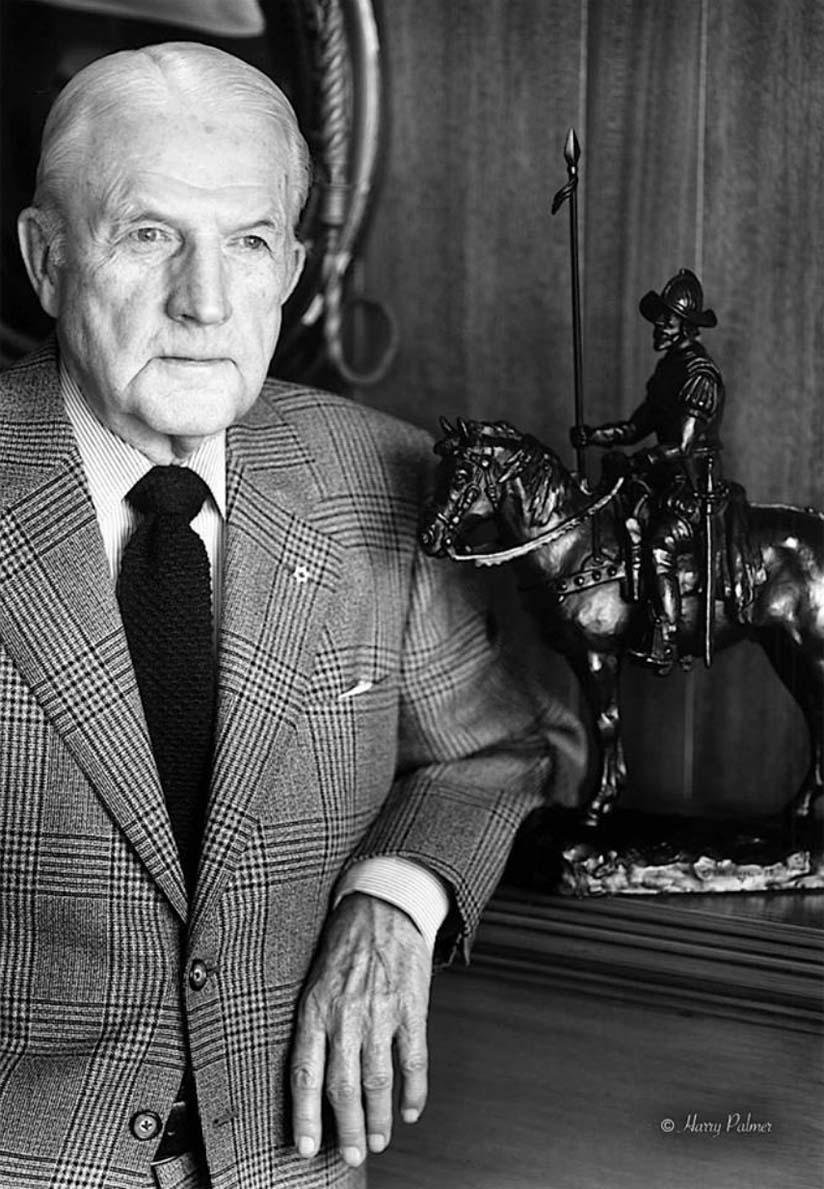 Crump proved too at this time that he was no respecter of railroading's sacred cows. MacPherson read a statement to him about track maintenance and asked if he agreed. Crump disagreed. "Do you know who made that statement?" MacPherson shouted. Crump said he did not. "It was made by Sir Edward Beatty himself when he had been president of the CPR for twenty years!" MacPherson said triumphantly. Beatty was a legal and financial genius, but in spite of his reputation as a great railway leader he never became well versed in railroad engineering. Crump didn't bat an eye as he replied, "I speak from a different viewpoint. I am an engineer. Sir Edward was a lawyer." Besides giving him a detailed knowledge of railroading, Crump's training has given him an almost personal love for locomotives. Arriving on an early morning train at Toronto once in 1947, he was stepping down to the platform when a large modern locomotive of a leading U.S. railway pulled up on an adjoining track. It was hauling CPR's New York train under a locomotive pooling agreement then in effect. The U.S. locomotive was covered with grime and streaked with white incrustations from its boiler. Crump turned to a CPR official with him and said, "Isn't that a tragic sight? Can you imagine a company treating a lovely piece of equipment like that?" A few days later the Toronto roundhouse, though not responsible for upkeep of the U.S. locomotives, was ordered to clean all U.S. locomotives as well as its own. Crump observed, If they don't know how to take care of locomotives, we'll do it for them." Among railroaders Crump already has a legendary reputation. Will the reputation spread and add another glamorous name to CPR's colorful roster of presidents? Crump's chances are good. But among all those involved, Crump seems the least interested. From time to time on Vancouver Island, when Crown Zellerbach's (CZ) road locomotive was indisposed, and Canadian Pacific (CP) had something they could spare for a while, CZ borrowed from the Esquimalt & Nanaimo Railway (E&N) collection, MLW S-4s, or Baldwin road switchers (but no Baldwin switcher to my knowledge) in earlier days, graduating later to a dynamic brake equipped chop-nosed GP9.One of my earliest CZ photo trips was on 28 Jan 1972, before I even began working for CP, so it was a borrowed Voightlander camera that let me document CZ borrowing Baldwin CP 8007 in the snow, shown her, and believed to be taken at the MacMillan Bloedel camp road+ crossing. Another CP Baldwin road switcher, 8001, which served during CZ's RS-3 number 4097's early years, was caught on 27 May 1974 at the west switch of Six Mile siding near Haslam Creek powering up after the descent from the Nanaimo River bridge. Three months later, CZ 4097 was out of action again for some reason. CP's last Baldwin in the old colours, 8000, the first of the road switchers, filled in, seen here with the CZ water car and eastward loads at Takala Road less than four miles from Ladysmith. Between approximately mileposts 3.4 and 4.6 on CZ their line paralleled the E&N. The goal for me, for years, was to catch two trains running close together along there. It was complicated by the fact that, if westbound and northbound from Ladysmith, one would have to wait for the other to clear the diamond crossing back at CZ mileage 1.6 to even start the "race". The crossings at Takala Road provided an easy access point but sadly no way to get an elevated viewpoint, and it was there on 29 Apr 1977 that first I caught a Nitinat caboose hop on the E&N returning to Wellcox with GP9s 8506 and 8531 with a borrowed S-4 number 7113, water car, and empties in the distance on the CZ line. That was the closest I ever came to catching side-by-side running there. The various CP MLW S-4s that were loaned to CZ served many times there, with number 7113 in particular, a frequent visitor. Here it is with log loads crossing Boulder Creek trestle. To my knowledge, only one CP GP9 was loaned to CZ, chop-nosed and dynamic brake equipped number 8619, well appreciated for its modernized features. It's seen here with westward empties beside the not-visible Nanaimo River at an un-recorded mileage. Note those as-rebuilt see-through number boards, a personal great irritant. Nice light bulbs!  Mountain Lights Various Authors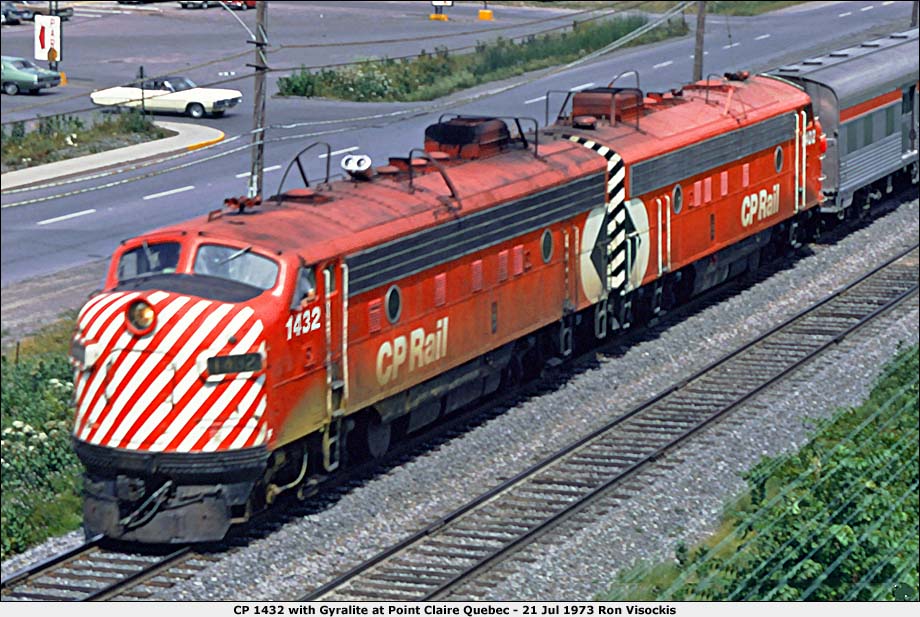 CP 1432 with a Gyralite at Point Claire Quebec - 21 Jul 1973 Ron Visockis. The Mars Light In the late 1920s, Jeremiah D. Kennelly, an aerial ladder truck driver with the Chicago Fire Department, had an idea to help get the attention of motorists who were supposed to yield the right-of-way. The Gyralite The Pyle-National Company was founded in 1897 by George C. Pyle, an inventor who patented several designs for locomotive headlights, and businessman Royal C. Vilas. Canadian Pacific Mountain Light The oscillating light units used on Canadian Pacific FP7A and FP9A locomotives were mounted on the centerline of the roof of the locomotive, at an estimated 20 feet back from the nose near the icicle breakers, and inclined upwards at an angle of 45 degrees. 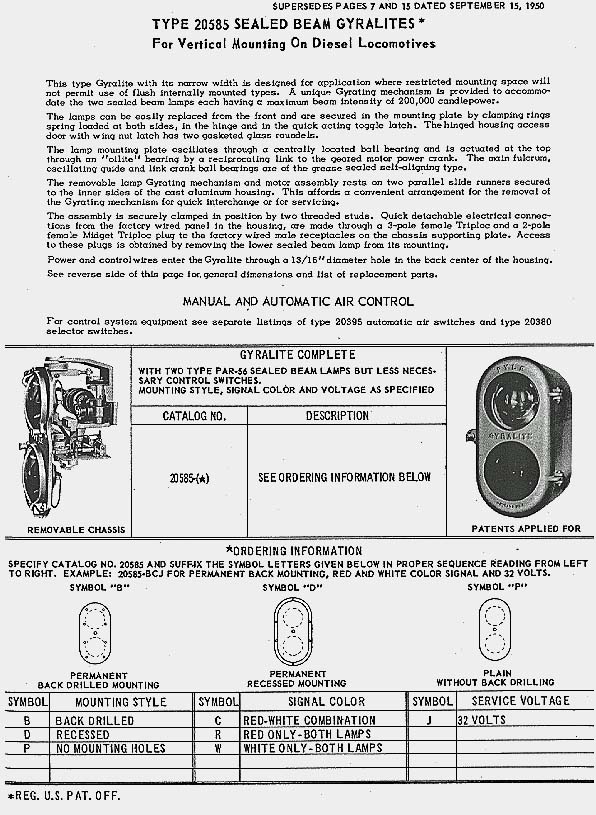 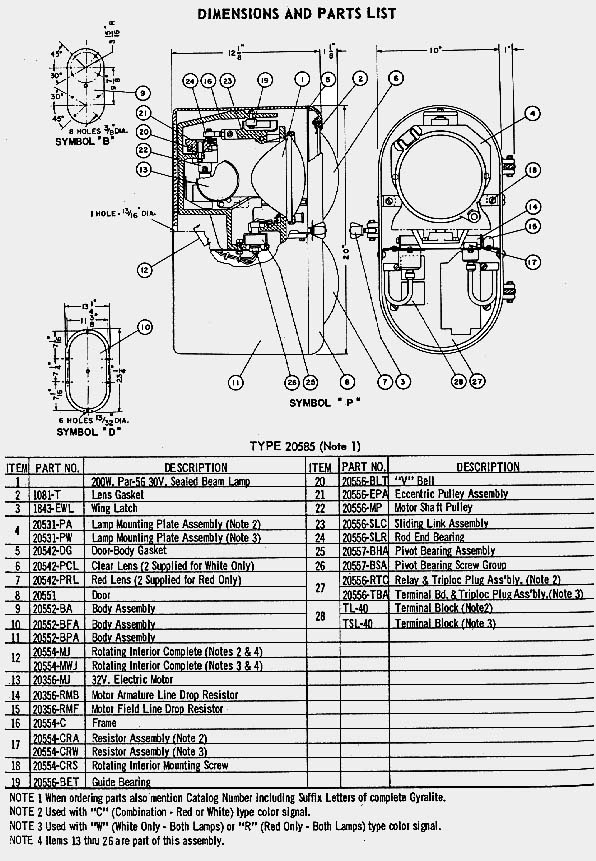 Gyralite type 20585 from the Pyle-National catalog. Pyle-National did not sell CP the bracket for this light, so it is speculated that these were made in CP's shops. 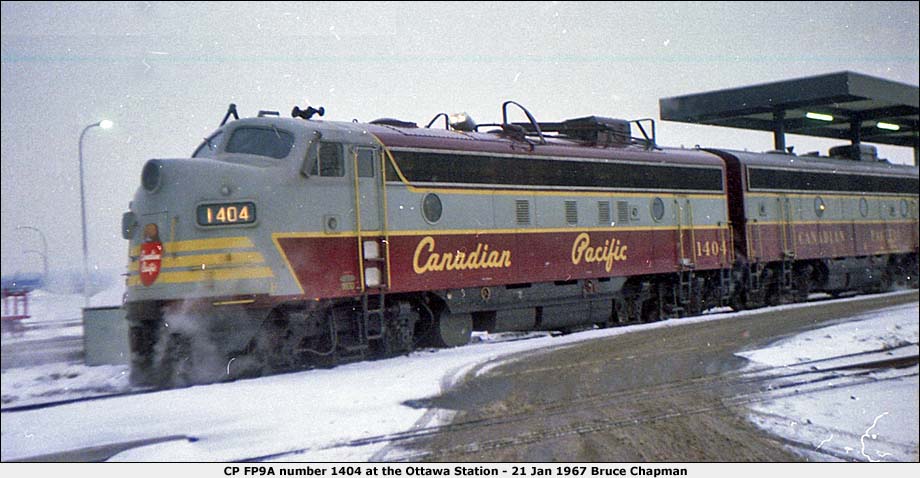 Canadian Pacific Railway FP9A number 1404 at the new Ottawa station - 21 Jan 1967 Bruce Chapman. This article was assembled from comments by the following individuals: Andy Cassidy, Doug Wilson, Philippe Gagnon, Bruce Chapman, Ron Visockis, Dave Page, Tim Organ, William Slim, David Othen, Joe Smuin, Ted Ellis, Doug Hatley, and also Wikipedia.  More Toast Andy Cassidy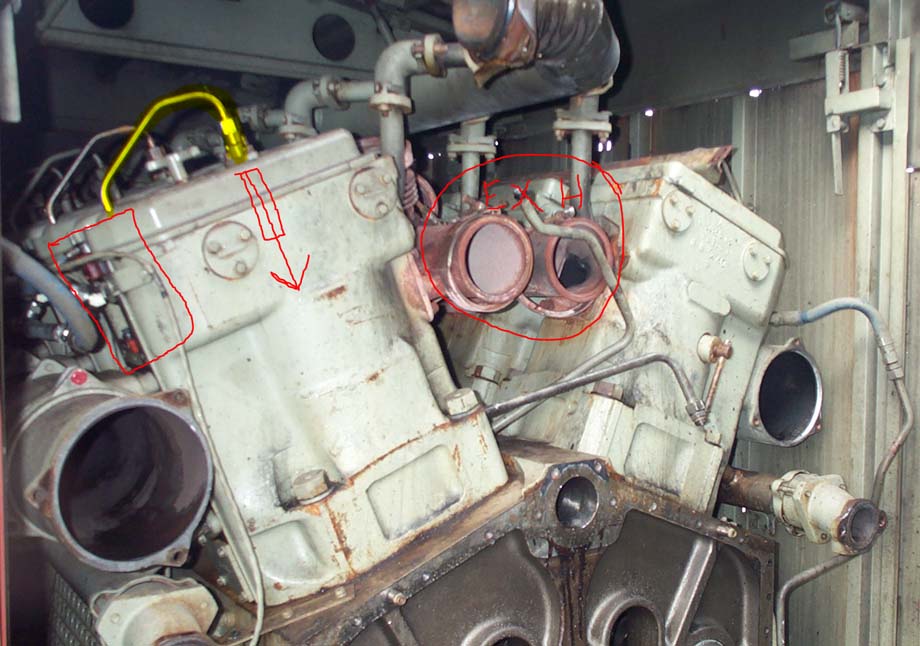 General Electric 7FDL diesel engine - Date? Andy Cassidy. I believe the term toaster was explained some time ago. Here's some additional technical data for you to think about. 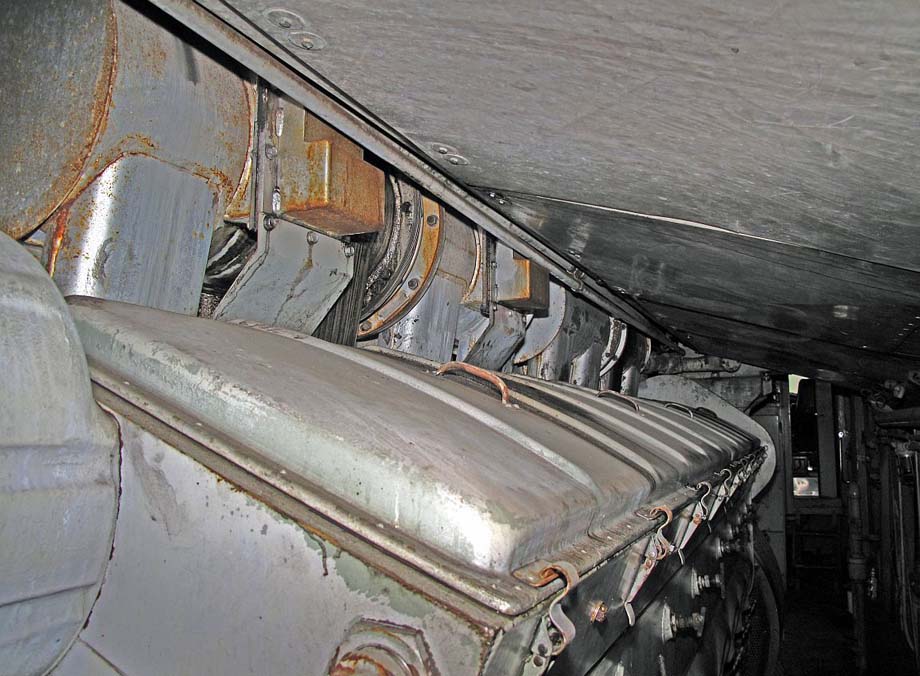 General Motors diesel engine with the lids open - Date? Andy Cassidy. 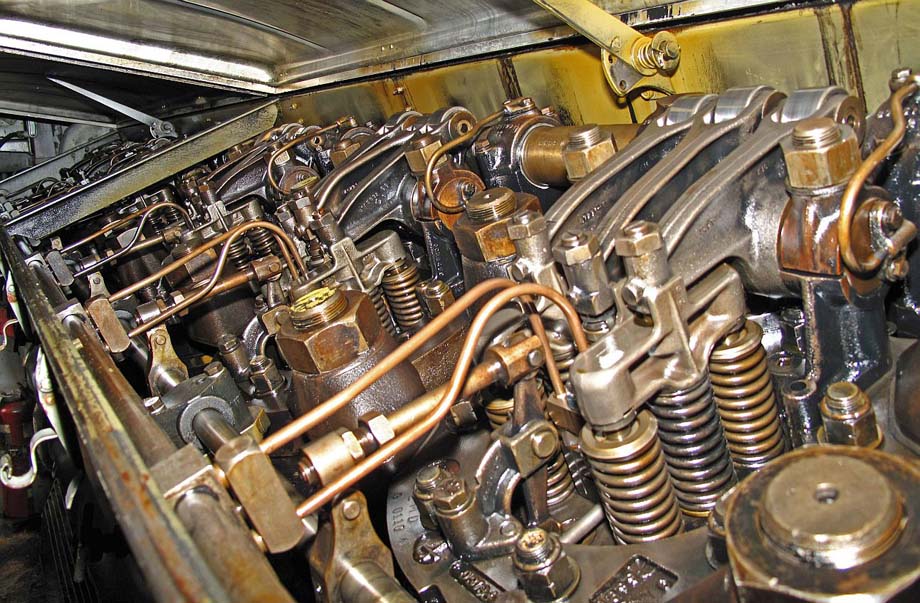 General Motors diesel engine with lids - Date? Andy Cassidy. On the other hand, a GM engine has its fuel system inside the top deck of the engine (normally closed with lids), as per the above photos.  This General Motors diesel engine fuel injector would be mounted vertically - 3 Jul 2005 Andy Cassidy. The injector itself is a self contained pump and injector.  Royal Canadian Pacific Andy CassidySANDFORD FLEMING The subject today is Canadian Pacific Railway's (CP) business train, many included in their "Royal Canadian Pacific" (RCP) luxury excursion train. The Consist CP 1401 Andy Cassidy. More Royal Canadian Pacific Canadian Pacific Railway Train number 32B-08, CP 7019 East, left Coquitlam Yard at 09:30 on the morning of 8 Sep 2021. Even More Royal Canadian Pacific In this 33-minute-long video, once you get past the advertizing, follow the Royal Canadian Pacific for the first two days of a journey from Calgary to Fernie.  Several still images in this video are labelled "for educational purposes". By including promotional advertizing within the video this negates any copyright protection the author was seeking to obtain by such labelling. OKthePK has not received, and will not receive, any compensation whatsoever for including a link to the video here. Several still images in this video are labelled "for educational purposes". By including promotional advertizing within the video this negates any copyright protection the author was seeking to obtain by such labelling. OKthePK has not received, and will not receive, any compensation whatsoever for including a link to the video here.The video is full of history of the Royal Canadian Pacific, and even features some exclusive footage inside some cars of the RCP fleet - 17 Oct 2020.  Tie Downs Andy Cassidy One must be careful to not stand near fast running equipment as you don't know what may be coming at you. 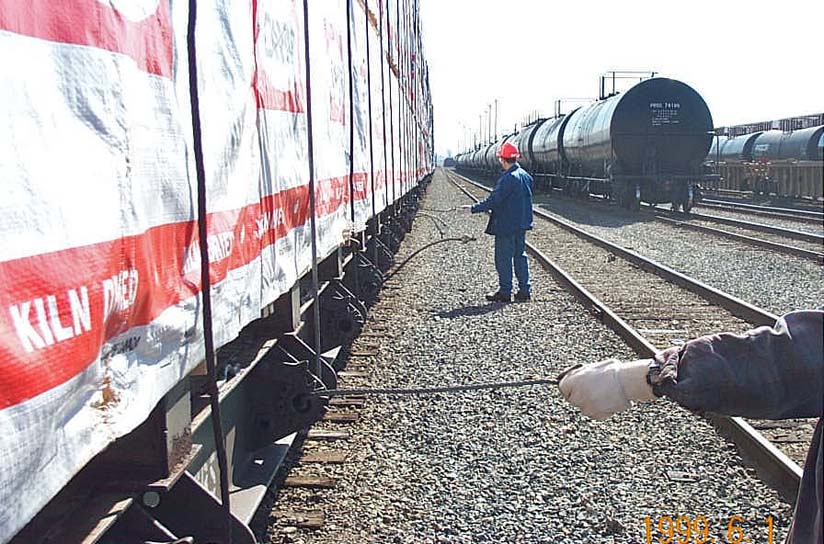 A dangerously secured load - 1 Jun 1999 Andy Cassidy. 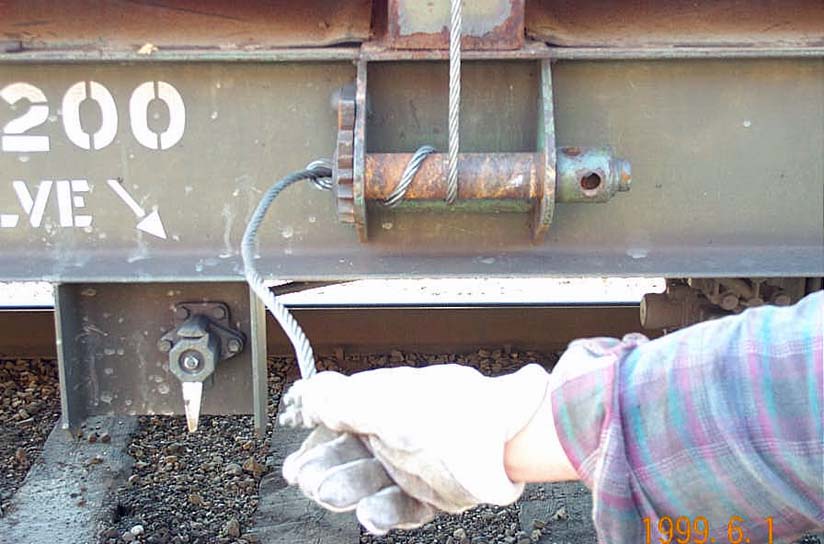 An extra long cable extends dangerously from the tie down point - 1 Jun 1999 Andy Cassidy.  Winterization Hatch Andy Cassidy 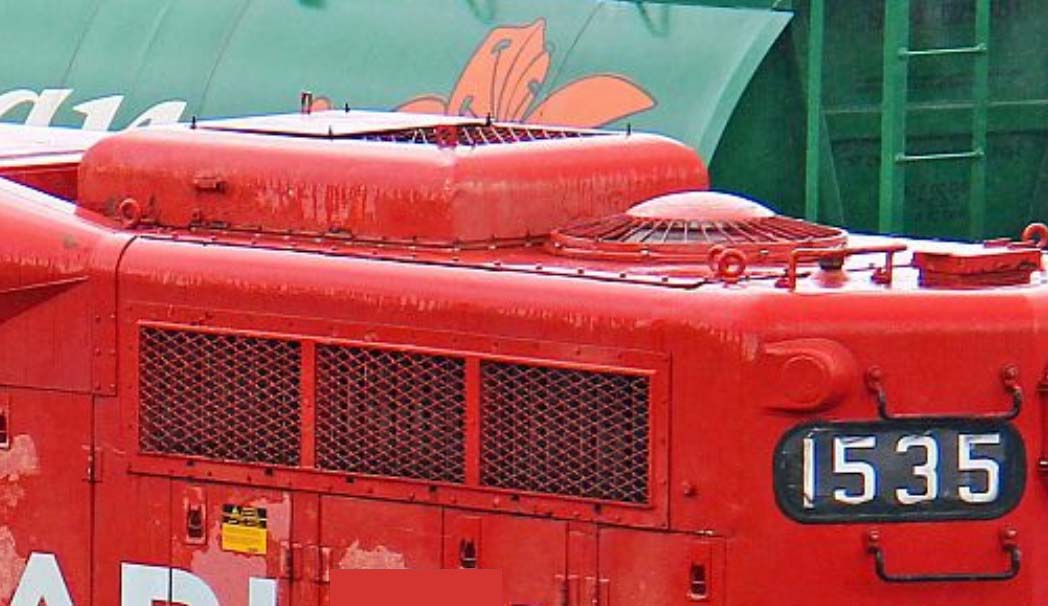 The winterization hatch over fan number 3 on Canadian Pacific Railway GP9u number 1535 - 25 Oct 2022 Andy Cassidy. Winterization Hatches were actually an option when GP9 locomotives were purchased back in the 1950s. |

